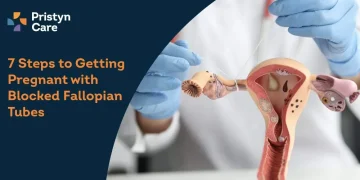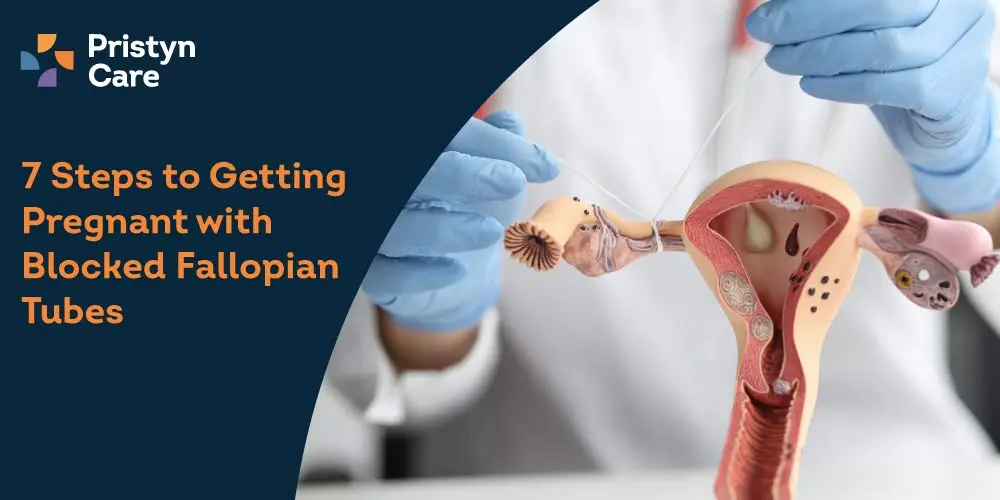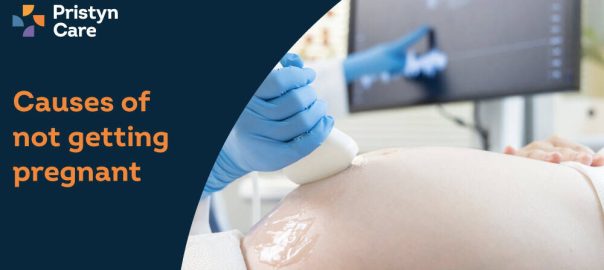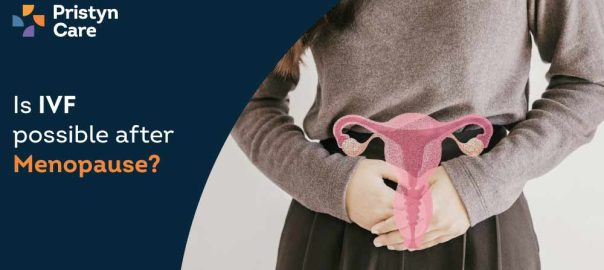![]() Views: 1,961
Views: 1,961
7 Steps to Getting Pregnant with Blocked Fallopian Tubes
Dedicated Support at Every Step!
Our Doctors are available 24 hours a day, 7 days a week to help you!
Call Us9513-316-643
However, medical advancements and specific strategies have made it possible to overcome this obstacle. In this blog, we will explore seven critical steps that can guide you through the process—from initial diagnosis to advanced treatments.
Whether it’s investigating suitable medical interventions or considering assisted reproductive technologies like IVF, we'll provide you with essential insights to navigate this journey. Join us as we get into these empowering steps, designed to bring you closer to the dream of parenthood.
Table of Contents
Pregnancy Issues with Blocked Fallopian Tubes
When the fallopian tubes are blocked, it often results in a condition known as tubal factor infertility, which accounts for about 1/4th of all infertility cases.
The blockages can occur due to various reasons including pelvic inflammatory disease (PID), endometriosis, previous surgeries in the pelvic area, or infections such as chlamydia or gonorrhea.
- Ectopic Pregnancy: One of the most serious complications arising from blocked tubes is an ectopic pregnancy. This occurs when a fertilised egg, unable to travel down to the uterus, implants itself in the fallopian tube or another abnormal location. Ectopic pregnancies are potentially life-threatening and require immediate medical intervention.
- Hydrosalpinx: Another issue is hydrosalpinx, which happens when the blockage causes the tube to fill with fluid. This buildup of fluid can backflow into the uterus, creating an environment hostile to both sperm and egg, thereby preventing implantation.
But can we get pregnant with blocked fallopian tubes? Yes, we can. The advancements in the field of medical science has made it all possible. Let us get to the essential steps to getting pregnant with blocked fallopian tubes.
No Cost EMI, Hassle-free Insurance Approval
The Path to Pregnancy: Steps for Overcoming Blocked Fallopian Tubes
When you're faced with the challenge of blocked fallopian tubes, the journey towards pregnancy can seem difficult. However, with the right approach and treatments, many women successfully overcome this hurdle.
Here are the seven steps to enhance your chances of conceiving, combining medical treatments and lifestyle adjustments for the best outcomes.
Step 1: Comprehensive Diagnosis
Achieving an accurate diagnosis is paramount in the journey toward conception, especially with a condition like blocked fallopian tubes that can be elusive in its early stages. A fertility specialist will likely recommend a hysterosalpingogram (HSG), an X-ray procedure that involves injecting a dye into the fallopian tubes to visualise any blockages or abnormalities.
Alternatively, a laparoscopy might be employed; this minimally invasive surgery uses a small incision and a camera to look directly at the fallopian tubes and other pelvic organs. These diagnostic tools are critical as they help determine the severity and location of the blockage, thus guiding potential treatment options.
Furthermore, a comprehensive diagnosis will also look into other potential infertility factors that might affect treatment choices, such as hormonal imbalances or issues with the uterine lining.
Step 2: Understanding Your Options
Once a diagnosis is established, it’s important to explore all the treatment avenues. The two main paths typically involve either surgical intervention to repair or remove the blockage or the use of assisted reproductive technologies (ART), such as in vitro fertilisation (IVF).
Each treatment has its own set of benefits and risks and will vary greatly depending on individual circumstances like age, overall health, and the specific nature of the fallopian tube blockage.
Surgical options can include procedures like salpingectomy (removal of part of the fallopian tube) or tuboplasty (repair of the fallopian tube), each with specific indications based on the blockage type. For many, ART provides a viable alternative, especially when surgery is not suitable or if it has not been successful.
Step 3: Surgical Interventions
For some women, surgical options to restore tubal patency can be effective. Procedures such as laparoscopic surgery can remove obstructions or repair damaged sections of the fallopian tubes. The success of these surgeries largely depends on the extent of the damage and the specific surgical techniques used.
Post-surgery, there is a risk of scar tissue formation which can re-block the tubes, so the decision to proceed with surgery should include discussions about potential long-term outcomes and the possibility of needing further interventions.
Additionally, patients should consider the potential for a recovery period that could affect their daily activities and work.
Step 4: Considering Assisted Reproductive Technologies (ART)
In cases where surgical interventions are either not an option or have failed to result in pregnancy, assisted reproductive technologies such as IVF are considered. IVF bypasses the natural process of egg fertilisation in the fallopian tubes by retrieving eggs directly from the ovaries, fertilising them in a lab, and then implanting the embryos directly into the uterus.
This process can be emotionally and physically demanding, so it's essential for couples to understand the full scope, including the stages of hormone therapy, egg retrieval, embryo development, and transfer.
The emotional and financial implications are significant and should be thoroughly discussed with a fertility counsellor.
Step 5: Lifestyle Adjustments
While medical treatments are at the forefront of addressing blocked fallopian tubes, lifestyle adjustments can play a supportive role in enhancing fertility. Diet and nutrition, for example, have a profound impact on reproductive health. A diet rich in antioxidants, proteins, and iron can improve egg quality and overall reproductive function.
Physical activity, particularly moderate exercise, can help maintain a healthy body weight and improve blood circulation, both of which are beneficial for fertility.
Moreover, reducing stress through mindfulness practices, adequate sleep, and possibly therapy can improve overall well-being, which in turn may enhance reproductive health.
Step 6: Emotional and Psychological Support
The psychological impact of dealing with infertility can be profound. Many couples experience a range of emotions from frustration and stress to sadness and isolation. It’s crucial to seek emotional and psychological support through counselling, support groups, or online forums where experiences and coping strategies can be shared.
Emotional support not only helps manage the stress of infertility treatments but can also strengthen relationships, which is essential when navigating such a challenging path.
Step 7: Regular Monitoring and Evaluation
Engaging in regular follow-ups with your fertility specialist is crucial for monitoring the progress of whatever treatment plan is in place. These evaluations allow for adjustments to be made based on how well the body is responding to treatment.
For instance, monitoring might reveal the need for adjustments in medication dosage or timing of procedures like egg retrieval in an IVF cycle. Moreover, regular monitoring helps identify and manage any side effects of treatments, ensuring that the patient’s health is maintained throughout the process.
Final Thoughts
Taking the journey to pregnancy with blocked fallopian tubes can be challenging, yet advancements in medical science offer substantial hope. The key steps outlined—from precise diagnosis to innovative treatments like IVF—equip you with strategies to enhance your chances of conceiving.
Embracing lifestyle changes and seeking emotional support are equally vital, complementing medical approaches to improve overall reproductive health. Stay proactive in consulting with your healthcare provider to tailor treatments to your unique situation.
Although the process can be demanding, with informed decision-making and persistence, many couples successfully overcome these obstacles and move closer to realising their dream of parenthood.
FAQs
Q1. What are the risks associated with surgical treatment for blocked fallopian tubes?
Surgical treatments, such as laparoscopy to remove blockages or repair tubes, carry risks like any surgery, including infection, bleeding, or damage to surrounding organs. There's also the risk of forming scar tissue, which can re-block the tubes. Discussing these risks with your surgeon can help you make an informed decision about your treatment options.
Q2. How long does it typically take to get pregnant after treating blocked fallopian tubes?
The time it takes to conceive after treatment for blocked fallopian tubes can vary widely depending on the method used and individual factors like age and overall health. After surgical interventions, some may conceive naturally within the first year, while others might need further treatments like IVF. Regular follow-ups with your fertility specialist will help monitor your progress.
Q3. Can blocked fallopian tubes affect IVF success rates?
Blocked fallopian tubes generally do not affect the success of IVF since this treatment bypasses the tubes altogether. The critical factors affecting IVF success are typically age, the quality of eggs and sperm, and the health of the uterus where the embryo is implanted.
Q4. What role does age play in the treatment of blocked fallopian tubes?
Age is a significant factor in the success of fertility treatments, including those for blocked fallopian tubes. Younger women generally have higher success rates with treatments like surgical repair or IVF. As age increases, the quality and quantity of a woman’s eggs decline, which can affect the success of both natural conception and assisted reproductive technologies.
Q5. What are the implications of having only one blocked fallopian tube?
Having one blocked fallopian tube can reduce fertility but doesn't make natural conception impossible. If the other tube is healthy and functional, it's still possible to conceive naturally. Treatments focus on maximizing the health and function of the unblocked tube or utilizing assisted reproductive technologies like IVF.
Q6. How does pelvic inflammatory disease (PID) relate to blocked fallopian tubes?
PID is one of the leading causes of blocked fallopian tubes. It is an infection of the female reproductive organs that can cause inflammation and scarring of the fallopian tubes. Prompt treatment of PID is crucial to prevent the development of blockages that can lead to infertility.
Q7. What preventive measures can be taken to avoid fallopian tube blockages?
Preventing sexually transmitted infections (STIs) through safe sex practices is one of the most effective ways to reduce the risk of fallopian tube blockages, as STIs can lead to pelvic inflammatory disease (PID), a major cause of such blockages. Regular medical check-ups and prompt treatment of any pelvic infections are also crucial.









